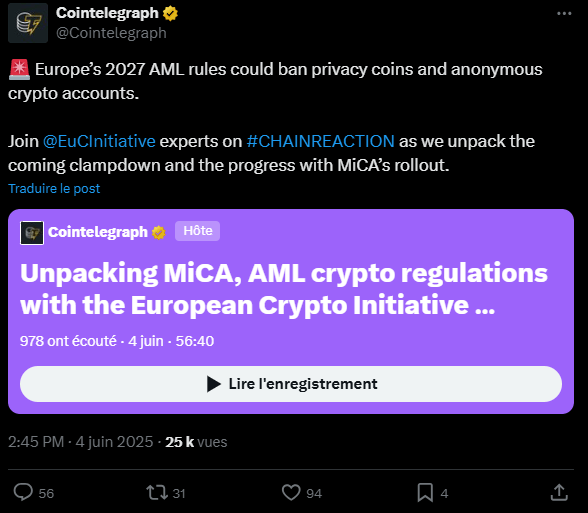Mica and after? Mica regulations (Markets in Crypto-Astets) entered into force on December 30, 2024 and it mainly aims to supervise the crypto in the European Union in order to protect investors, avoid fraud and manage the reserves of Stablecoins. But while the text is still in applicationEuropean regulators are already thinking about it and looking at decentralized finance (DEFI) which remains for the moment outside the legal framework.
- Mica regulations have been set up to supervise the cryptocurrency market in the European Union, but decentralized finance remains outside its framework.
- European regulators provide targeted legislative updates rather than a new Mica II regulation, with regular revisions to fill the existing gaps.
The DEFI remains outside the legal framework of Mica
In a recent intervention As part of the program Chain Reaction x Spaces from Cointelegraph, Vyara Savovaresponsible for the policy of European Crypto Initiative (Euci), said that the protocols DEFI remained in a sort of legal vagueness And that should be interested in it quickly.
She also clarified that the Challenge was « Theoretically outside the field of application of mica » And that it would therefore be necessary to define what the legislators mean there. To do this, the European authorities should start working on the subject towards the mid-2026.
Indeed, the initial framework of Mica has been criticized for its shortcomings concerning decentralized protocols, as it demanded that the platforms Challenge Respect the same license and Know Your Customer (KYC) requirements as traditional financial companies. However, an amendment to the text, the Considering 22stipulates that completely decentralized cryptoactive service providers « Should not enter the scope of these regulations ».


Crypto: Mica II should not see the light of day
But then, we must expect a new regulation Mica II To fill these shortcomings? Not really, according to Marina Markezicexecutive director and co -founder of the Euci, who said that « The possibility of a Mica II will not happen ». She added more that the discussions underway on the stablecoins could lead to Legislative updates targeted rather than a complete suite of Mica.
It must be said that European legislators still have work to do with the final implementation of Mica, which should be revised every 12 to 18 months to fill any gaps. L’Ue must also adopt new rules against money laundering (AML) which restrict the use of private tokens and Anonymous cryptos accounts. These provisions should come into force in 2027.
Mica regulations are therefore far from frozen and will have to adapt to rapid developments in the cryptocurrency sector. Decentralized finance, which represents an increasing share of the market, will also have to find its place in this legal framework. It remains to be seen how European regulators will succeed in reconciling innovation and consumer protection without slowing down the competitiveness of the continent. But we do not hide from you that we are a little worried when we see The turn of events on the old continent.
